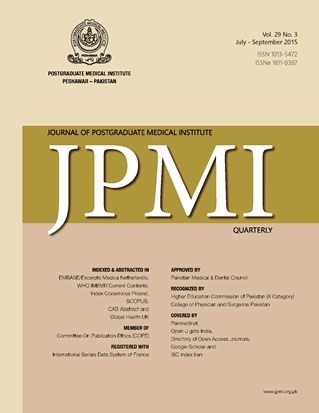COMPARISON OF EFFECTIVENESS OF 4% ARTICAINE BUCCAL INFILTRATION VERSUS INFERIOR ALVEOLAR NERVE BLOCK IN SYMPTOMATIC MANDIBULAR 1ST MOLAR TOOTH
Main Article Content
Abstract
Objective: To evaluate the pulpal anaesthesia of mandibular 1st molar by us -ing 4% articaine in two different techniques i-e buccal infiltration and inferior
alveolar nerve block.
Methodology: Ninty emergency patients who had 1st molar diagnosed with
irreversible pulpitis participated in the study. Subjects were randomly allo -cated into two groups One group received 4% articaine buccal infiltration
and the other group received inferior alveolar nerve block of 4% articaine.
Subjects' self reported pain response was recorded on Heft Parker Visual An-alogue Scale after local anesthetic administration during access cavity prepa-ration and pulp extirpation.
Results: Mean age of subjects was 32.96 years ± 10.105 years. The success
rate of 4% articaine buccal infiltration was 71.11% whereas the success rate of
4% articaine inferior alveolar nerve block was 64.4%. There was no statistically
significant difference between two groups.
Conclusion: Since there was no difference between the two procedures 4%
articaine buccal infiltration can be considered a viable alternative to inferior
alveolar nerve block in securing successful pulpal anesthesia for endodontic
therapy.
alveolar nerve block.
Methodology: Ninty emergency patients who had 1st molar diagnosed with
irreversible pulpitis participated in the study. Subjects were randomly allo -cated into two groups One group received 4% articaine buccal infiltration
and the other group received inferior alveolar nerve block of 4% articaine.
Subjects' self reported pain response was recorded on Heft Parker Visual An-alogue Scale after local anesthetic administration during access cavity prepa-ration and pulp extirpation.
Results: Mean age of subjects was 32.96 years ± 10.105 years. The success
rate of 4% articaine buccal infiltration was 71.11% whereas the success rate of
4% articaine inferior alveolar nerve block was 64.4%. There was no statistically
significant difference between two groups.
Conclusion: Since there was no difference between the two procedures 4%
articaine buccal infiltration can be considered a viable alternative to inferior
alveolar nerve block in securing successful pulpal anesthesia for endodontic
therapy.
Article Details
How to Cite
1.
Zain M, Khattak S ur R, Shah SA, Sikandar H, Khattak Y. COMPARISON OF EFFECTIVENESS OF 4% ARTICAINE BUCCAL INFILTRATION VERSUS INFERIOR ALVEOLAR NERVE BLOCK IN SYMPTOMATIC MANDIBULAR 1ST MOLAR TOOTH. J Postgrad Med Inst [Internet]. 2015 Dec. 12 [cited 2025 Dec. 5];29(3). Available from: https://jpmi.org.pk/index.php/jpmi/article/view/1755
Issue
Section
Original Article
Work published in JPMI is licensed under a
Creative Commons Attribution-NonCommercial 2.0 Generic License.
Authors are permitted and encouraged to post their work online (e.g., in institutional repositories or on their website) prior to and during the submission process, as it can lead to productive exchanges, as well as earlier and greater citation of published work.


